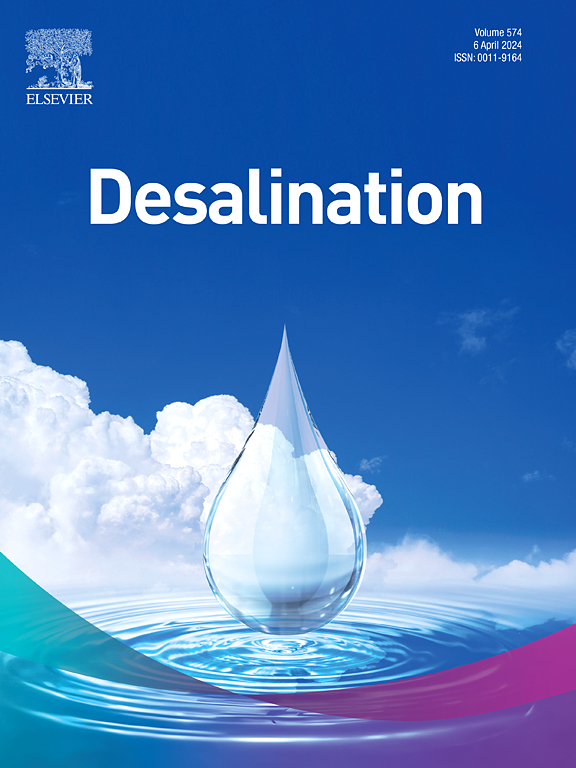From comparison to integration: Enhancing forward osmosis performance prediction with mathematical and RBF neural network models
IF 8.3
1区 工程技术
Q1 ENGINEERING, CHEMICAL
引用次数: 0
Abstract
Reliable prediction of forward osmosis (FO) performance requires advanced models that can handle the complex, nonlinear interactions within operational conditions. This study developed, compared, and integrated mathematical and radial basis function neural network (RBFNN) models to predict the performance of pilot-scale plate-and-frame FO system. RBFNN demonstrates strong generalization capabilities for capturing nonlinear relationships, making it particularly effective in noisy experimental environments typical of FO applications. Both models demonstrated high accuracy within the experimental data ranges (R2 > 0.97). The mathematical model provided consistent predictions and insights into internal module dynamics, while the RBFNN exhibited high computational efficiency. However, the RBFNN showed limitations in predicting recovery accuracy for operational ranges with insufficient data. To address this, we introduced a data distance index to assess the reliability of RBFNN predictions, particularly in extrapolation scenarios. We then integrated the approaches using the mathematical model for data imputation to expand the RBFNN's training dataset. The integrated model, retrained with augmented data, achieved an R2 of 0.9920 and an RMSE of 0.3414 LMH for water flux prediction. This approach not only provides more reliable predictions but also enhances the understanding of key FO performance parameters through Shapley Additive exPlanations (SHAP) analysis. This synergistic method facilitates efficient FO system design and operation by optimizing process parameters under diverse conditions. The current study highlights the effectiveness of combining physics-based modeling with machine learning in membrane technology, improving the robustness of predictive tools for water treatment applications. Furthermore, the data distance index offers significant implications for evaluating prediction reliability in other processes with limited training data.

从比较到整合:用数学和RBF神经网络模型增强正向渗透性能预测
正向渗透(FO)性能的可靠预测需要先进的模型,可以处理操作条件下复杂的非线性相互作用。本研究开发、比较并整合数学模型与径向基函数神经网络(RBFNN)模型,以预测中试规模板框FO系统的性能。RBFNN在捕获非线性关系方面表现出强大的泛化能力,使其在典型的FO应用的嘈杂实验环境中特别有效。两种模型在实验数据范围内均具有较高的精度(R2 >;0.97)。数学模型提供了一致的预测和对内部模块动态的见解,而RBFNN表现出较高的计算效率。然而,在数据不足的操作范围内,RBFNN在预测恢复精度方面存在局限性。为了解决这个问题,我们引入了一个数据距离指数来评估RBFNN预测的可靠性,特别是在外推场景中。然后,我们使用数据输入的数学模型集成了这些方法,以扩展RBFNN的训练数据集。综合模型经增广数据再训练后,水通量预测的R2为0.9920,RMSE为0.3414 LMH。该方法不仅提供了更可靠的预测,而且通过Shapley加性解释(SHAP)分析增强了对关键FO性能参数的理解。这种协同方法通过优化不同条件下的工艺参数,促进了FO系统的高效设计和运行。目前的研究强调了将基于物理的建模与膜技术中的机器学习相结合的有效性,提高了水处理应用预测工具的鲁棒性。此外,数据距离指数对在训练数据有限的其他过程中评估预测可靠性具有重要意义。
本文章由计算机程序翻译,如有差异,请以英文原文为准。
求助全文
约1分钟内获得全文
求助全文
来源期刊

Desalination
工程技术-工程:化工
CiteScore
14.60
自引率
20.20%
发文量
619
审稿时长
41 days
期刊介绍:
Desalination is a scholarly journal that focuses on the field of desalination materials, processes, and associated technologies. It encompasses a wide range of disciplines and aims to publish exceptional papers in this area.
The journal invites submissions that explicitly revolve around water desalting and its applications to various sources such as seawater, groundwater, and wastewater. It particularly encourages research on diverse desalination methods including thermal, membrane, sorption, and hybrid processes.
By providing a platform for innovative studies, Desalination aims to advance the understanding and development of desalination technologies, promoting sustainable solutions for water scarcity challenges.
 求助内容:
求助内容: 应助结果提醒方式:
应助结果提醒方式:


